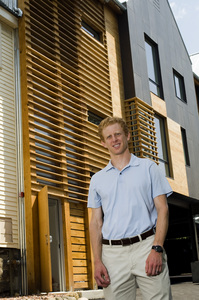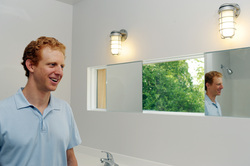Tenants move into first gold-level LEED certified Ann Arbor student housing complex
University of Michigan business student Nirav Shah and his roommates picked out their housing for the upcoming semester the way most students do.
"I feel like this will be a little nicer, a little closer," said Shah, who recently moved into a brand new apartment building at 523 Packard St.

Owner and Architect Warren Samberg is pictured in front of the addition to his historic rental house at 523 Packard.
Eric Bronson | For AnnArbor.com
With its geothermal heating system, well-insulated building envelope and recycled building materials, that new apartment building will hold the distinction of being the first student housing complex at U-M to have gold-level LEED green building certification.
And as someone who has worked at a private equity firm investing in proven green energy technology projects, Shah said it was a perk when picking his new digs.
"The first thing people think of when you say green housing are solar panels on the roof," Shah said.
But when he and his roommates first looked at plans, they didn't even realize they were looking at a building constructed to meet LEED standards. Still, he said, "it's kind of cool to say we live in a green apartment."
LEED, which stands for Leadership in Energy and Environmental Design, is the U.S. Green Building Council's official system that allows new and renovated buildings to be certified as developed with more environmentally-sustainable concepts. Points toward the certification are earned for water and energy efficiency, indoor environmental quality and sustainability, among other things.
The new apartments on Packard are actually part of an addition and renovation to a large historic rental house in central Ann Arbor. Owner and LEED accredited architect Warren Samberg said he drew up the plans himself and wanted to mix a feel of historic residential with the feel of an industrial space and the addition as a nod to the history of the Packard/Hill Street area.
The area's roots were residential, commercial and industrial back in the 1850s, he said. There was a sawmill at that corner where a popular sandwich shop now sits.
Samberg also had the idea that a more environmentally-friendly rental property would attract students, giving him a chance to work on a project he was passionate about and one that would ultimately pay for itself in efficiency.
"It's just choices you make," Samberg said. "You have to make a strategy why you choose your material and make decisions based on your budget. I chose geothermal, which can cost five to six times a regular heating system, but get more back in nine to 11 years because it's so efficient. It also depends on geography. In Arizona, your approach might have been solar. In this climate, it might make sense to go with geothermal."
Working with Bloom General Contracting, they started by putting in a geothermal heating and cooling system, buried deep behind the existing home, and retrofitted the existing house's duct work for the system. Samberg added a rain management system to slow excess rain runoff and direct it into a storm water system.
They constructed the two six-bedroom apartment addition above the geothermal field and small parking lot on the property, Samberg said. It is covered in reclaimed wood siding.
Visitors enter the apartment via a set of stairs that are created to have an "industrial feel" with concrete and steel stairs. The entrance to the apartment guides people over a bamboo floor into an open living room area that blends with the dining room and kitchen area.

Owner and architect Warren Samberg pictured in one of 523 Packard's new bathrooms.
Eric Bronson | For AnnArbor.com
One of the ideas in the space was to create an area that would be naturally lit and well-ventilated by the windows in the living areas. But those windows are also energy efficient and play a role in creating a tighter building envelope for better insulation.
Kitchen cabinets, walls and other surfaces are low in toxic chemicals and volatile organic compounds. The apartments have stainless steel Energy Star appliances and low-flow water faucets. The carpet is the brand SmartStrand and is made with a renewably sourced polymer.
The hallways, which lead to the six small bedrooms and two bathrooms in each apartment, are lit by florescent Energy Star light fixtures built into the walls. Rather than having mirrors cover the wall of the bathroom, natural light is able to illuminate the space by having windows with small mirrors placed in sections across them.
According to the USGBC, many of the local LEED buildings are commercial projects, including Ann Arbor Architects Collaborative, the ALDI Food Markets, IMRA America's building, the NSF International building addition, Skyline High School and Washtenaw Community College's Health and Fitness Center.
U-M's S.T. Dana Buiding's renovations were LEED-certified, and U-M announced all future major construction projects will also meet the USGBC's silver standard. There are a number of certified or pending LEED homes in the Ann Arbor and surrounding areas.
A number of new kinds of student housing are emerging nationwide and within the state that are LEED certified, but the examples are mostly public buildings at universities, including U-M. For instance, the newly created U-M North Quadrangle residential and academic complex was designed with sustainability and energy-efficiency techniques built in to beat energy efficiency standard by 30 percent.
But as far as privately developed apartment complexes meant to mark the stamp of energy efficiency, "this is very early in the game," said Paul Goldsmith, a board member of the USGBC Detroit Chapter. "This is one of the first in the country as far as I know."
Part of the reason is LEED standards didn't initially lend themselves to residential projects and the rating system is catching up, he said. In addition, debate has raged about the upfront costs linked to meeting energy efficiency requirements and whether it was worth it.
Research has shown companies are often willing to pay a premium for LEED rated commercial property, but similar research about residential renters isn't available, Goldsmith said. Still, it'd be foolish for landlords to ignore potential energy efficiency improvements as they make updates to their properties, experts say. Within 10 to 15 years, current LEED standards are expected to become part of regular building codes
"Younger generations are much more aware of their energy use and impact on the environment," Goldsmith said. "It makes business sense and common sense."
The biggest challenge for Samberg in creating the 523 Packard addition wasn't incorporating green elements into the building, but more logistical issues with keeping current rental tenants accommodated while trying to build an addition to the property, he said. Samberg said he thought more environmentally friendly student housing would become more available in coming years.
"I hope we do," Samberg said. "I'm excited I could bring a project like this and create an option like this for students here. I think in a place like Ann Arbor where there is a lot of interest in being environmentally friendly … hopefully more landlords will want to keep up with the pace of improvements made in the city."
Tina Reed covers health and the environment for AnnArbor.com. You can reach her at tinareed@annarbor.com, call her at 734-623-2535 or find her on Twitter @TreedinAA.te


Comments
Aaditi
Mon, Jan 3, 2011 : 4:51 a.m.
A few of the rating systems have their own unique, additional sections such as the LEED for Homes rating System as has an additional Location & Linkages section and Education and Awareness section while the LEED for Neighborhood Development rating system has an additional Green Building and Infrastructure as well as Neighborhood Pattern and Design section. http://www.greenliving9.com/leed-certification-an-overview.html
Mick52
Mon, Aug 23, 2010 : 11:42 a.m.
So there is no research on whether or not renters will pony up more $$ for LEED systems. I was wondering if and how this affects rent. Is the rent in this building the same as surrounding buildings? Or does the energy savings on utilities equal out the increased rent? I hope nothing goes wrong with the geothermal system under the addition in the next 9 to 11 years. I'm interested in the geo thermal systems, but they are so expensive they are out of my reach.
Ruth
Mon, Aug 23, 2010 : 11:40 a.m.
Any information on cost comparison, etc. with "standard" renovation?
montyman
Mon, Aug 23, 2010 : 8:04 a.m.
My college dormroom more closely resembled a third world prison cell then this. Amazing what they have available to them.